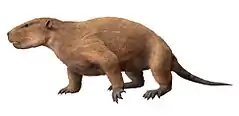| Taeniolabidoidea Temporal range: Late Cretaceous-Paleocene | |
|---|---|
 | |
| Taeniolabis taoensis life reconstruction. | |
| Scientific classification | |
| Domain: | Eukaryota |
| Kingdom: | Animalia |
| Phylum: | Chordata |
| Class: | Mammalia |
| Order: | †Multituberculata |
| Suborder: | †Cimolodonta |
| Superfamily: | †Taeniolabidoidea |
| Families and genera | |
Taeniolabidoidea is a group of extinct mammals known from North America and Asia. They were the largest members of the extinct order Multituberculata, as well as the largest non-therian mammals. Lambdopsalis even provides direct fossil evidence of mammalian fur in a fairly good state of preservation for a 60-million-year-old animal. Some of these animals were large for their time; Taeniolabis taoensis is the largest known multituberculate and though smaller, Yubaatar is the largest known Mesozoic Asian multituberculate.[2] Average members of the Taeniolaboidea were about beaver-sized and the largest even reached sizes comparable to the largest beavers like Castoroides, up to about 100 kilograms.[1]
The group was initially established as a suborder, before being assigned the rank of a superfamily by McKenna and Bell in 1997 (see Kielan-Jaworowska and Hurum (2001) p. 391-392). Two families are recognised: the primarily North American Taeniolabididae, composed of Taeniolabis and Kimbetopsalis, and the exclusively Asian Lambdopsalidae, composed of Lambdopsalis, Sphenopsalis and Prionessus, with Valenopsalis being a basal form outside of either clade.[1] Some of the fossils are well-preserved. Though the possible taeniolabidoid Bubodens is known from the Lancian Late Cretaceous deposits of South Dakota,[1] and Yubaatar is known from Late Cretaceous deposits in the Henan Province,[2] the clade is otherwise only clearly represented in Paleocene strata.[1]
Derived characteristics of the taxon (apomorphies) include: "snout short and wide with anterior part of zygomatic arches directed transversely, resulting in a square-like shape of the skull (shared with Kogaionidae); frontals small, pointed posteriorly, almost or completely excluded from the orbital rim," (Kielan-Jaworowska and Hurum 2001, p. 417).
References
- 1 2 3 4 5 6 7 8 9 Williamson, Thomas E.; Brusatte, Stephen L.; Secord, Ross; Shelley, Sarah (2015). "A new taeniolabidoid multituberculate (Mammalia) from the middle Puercan of the Nacimiento Formation, New Mexico, and a revision of taeniolabidoid systematics and phylogeny". Zoological Journal of the Linnean Society. 177: 183–208. doi:10.1111/zoj.12336.
- 1 2 L. Xu, X. Zhang, H. Pu, S. Jia, and J. Zhang, J., and J. Meng. 2015. Largest known Mesozoic multituberculate from Eurasia and implications for multituberculate evolution and biology. Scientific Reports 5(14950):1-11
- Kielan-Jaworowska Z. and Hurum J.H., "Phylogeny and Systematics of multituberculate mammals". Paleontology 44, p. 389-429, 2001.
- McKenna M.C. and Bell S.K., (1997), Classification of Mammals Above the Species Level. Columbia University Press, 1997.
- Much of this information has been derived from MESOZOIC MAMMALS: Eucosmodontidae, Microcosmodontidae and Taeniolabidoidea, an Internet directory.
